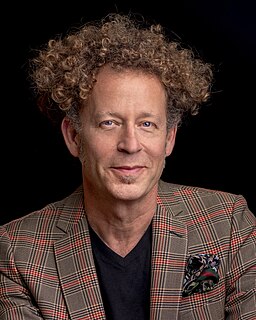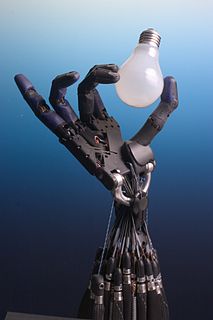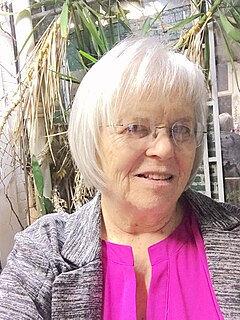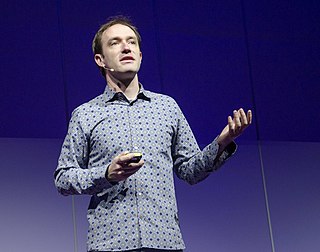An android is a robot or other artificial being designed to resemble a human, and often made from a flesh-like material. Historically, androids were completely within the domain of science fiction and frequently seen in film and television, but recent advances in robot technology now allow the design of functional and realistic humanoid robots.

Lego Mindstorms is a hardware and software structure which is produced by Lego for the development of programmable robots based on Lego building blocks. Each version of the system includes a computer Lego brick that controls the system, a set of modular sensors and motors, and Lego parts from the Technic line to create the mechanical systems.

The MIT Media Lab is a research laboratory at the Massachusetts Institute of Technology, growing out of MIT's Architecture Machine Group in the School of Architecture. Its research does not restrict to fixed academic disciplines, but draws from technology, media, science, art, and design. As of 2014, Media Lab's research groups include neurobiology, biologically inspired fabrication, socially engaging robots, emotive computing, bionics, and hyperinstruments.
Draper Laboratory is an American not-for-profit research and development organization, headquartered in Cambridge, Massachusetts; its official name is The Charles Stark Draper Laboratory, Inc. The laboratory specializes in the design, development, and deployment of advanced technology solutions to problems in national security, space exploration, health care and energy.

Cynthia Breazeal is an American roboticist and entrepreneur. She is a former chief scientist and chief experience officer of Jibo, a company she co-founded in 2012 for creating social robots in the home.
Domo is an experimental robot made by MIT designed to interact with humans. The brainchild of Jeff Weber and Aaron Edsinger, cofounders of Meka Robotics, its name comes from the Japanese phrase for "thank you very much", domo arigato, as well as the Styx song, "Mr. Roboto". The Domo project was originally funded by NASA, and has now been joined by Toyota in funding robot's development.

The Museum of Science (MoS) is a science museum and indoor zoo in Boston, Massachusetts, located in Science Park, a plot of land spanning the Charles River. Along with over 700 interactive exhibits, the museum features a number of live presentations throughout the building every day, along with shows at the Charles Hayden Planetarium and the Mugar Omni Theater, the only domed IMAX screen in New England. The museum is also an accredited member of the Association of Zoos and Aquariums (AZA) and is home to over 100 animals, many of which have been rescued and rehabilitated.
Developmental robotics (DevRob), sometimes called epigenetic robotics, is a scientific field which aims at studying the developmental mechanisms, architectures and constraints that allow lifelong and open-ended learning of new skills and new knowledge in embodied machines. As in human children, learning is expected to be cumulative and of progressively increasing complexity, and to result from self-exploration of the world in combination with social interaction. The typical methodological approach consists in starting from theories of human and animal development elaborated in fields such as developmental psychology, neuroscience, developmental and evolutionary biology, and linguistics, then to formalize and implement them in robots, sometimes exploring extensions or variants of them. The experimentation of those models in robots allows researchers to confront them with reality, and as a consequence, developmental robotics also provides feedback and novel hypotheses on theories of human and animal development.

Scott Fisher is the Professor and Founding Chair of the Interactive Media Division in the USC School of Cinematic Arts at the University of Southern California, and Director of the Mobile and Environmental Media Lab there. He is an artist and technologist who has worked extensively on virtual reality, including pioneering work at NASA, Atari Research Labs, MIT's Architecture Machine Group and Keio University.

Kenneth Yigael Goldberg is an American artist, writer, inventor, and researcher in the field of robotics and automation. He is professor and chair of the industrial engineering and operations research department at the University of California, Berkeley, and holds the William S. Floyd Jr. Distinguished Chair in Engineering at Berkeley, with joint appointments in Electrical Engineering and Computer Science (EECS), Art Practice, and the School of Information. Goldberg also holds an appointment in the Department of Radiation Oncology at the University of California, San Francisco.

Leonardo is a 2.5 foot social robot, the first created by the Personal Robots Group of the Massachusetts Institute of Technology. Its development is credited to Cynthia Breazeal. The body is by Stan Winston Studios, leaders in animatronics. Its body was completed in 2002. It was the most complex robot the studio had ever attempted as of 2001. Other contributors to the project include NevenVision, Inc., Toyota, NASA's Lyndon B. Johnson Space Center, and the Navy Research Lab. It was created to facilitate the study of human–robot interaction and collaboration. A DARPA Mobile Autonomous Robot Software (MARS) grant, Office of Naval Research Young Investigators Program grant, Digital Life, and Things that Think consortia have partially funded the project. The MIT Media Lab Robotic Life Group, who also studied Robonaut 1, set out to create a more sophisticated social-robot in Leonardo. They gave Leonardo a different visual tracking system and programs based on infant psychology that they hope will make for better human-robot collaboration. One of the goals of the project was to make it possible for untrained humans to interact with and teach the robot much more quickly with fewer repetitions. Leonardo was awarded a spot in Wired Magazine’s 50 Best Robots Ever list in 2006.

The MIT School of Architecture and Planning is one of the five schools of the Massachusetts Institute of Technology, located in Cambridge, Massachusetts. Founded in 1865 by William Robert Ware, the school offered the first formal architectural curriculum in the United States, and the first architecture program in the world operating within the establishment of a university. MIT SAP is considered a global academic leader in the design fields and one of the most prestigious schools in the world. MIT's department of architecture has consistently ranked among the top architecture/built environment schools in the world, and from 2015 to 2018 was ranked highest in the world in QS World University Rankings. In 2019, it was ranked second to The Bartlett but regained the number one position in the 2020 rankings.

The NTNU University Museum in Trondheim is one of seven Norwegian university museums with natural and cultural history collections and exhibits. The museum has research and administrative responsibility over archaeology and biology in Central Norway. Additionally, the museum operates comprehensive community outreach programs and has exhibits in wooden buildings in Kalvskinnet.

Daniela L. Rus is a Romanian-American roboticist, the Director of the MIT Computer Science and Artificial Intelligence Laboratory (CSAIL), and Andrew and Erna Viterbi Professor in the Department of Electrical Engineering and Computer Science (EECS) at the Massachusetts Institute of Technology.

Robotics is an interdisciplinary branch of computer science and engineering. Robotics involves design, construction, operation, and use of robots. The goal of robotics is to design machines that can help and assist humans. Robotics integrates fields of mechanical engineering, electrical engineering, information engineering, mechatronics, electronics, bioengineering, computer engineering, control engineering, software engineering, mathematics, etc.

William John Mitchell was an Australian-born author, educator, architect and urban designer, best known for leading the integration of architectural and related design arts practice with computing and other technologies.

Neri Oxman is an American–Israeli designer and professor at the MIT Media Lab, where she leads the Mediated Matter research group. She is known for art and architecture that combine design, biology, computing, and materials engineering.

Cynthia Solomon is an American computer scientist known for her work in artificial intelligence (AI) and popularizing computer science for students. She is a pioneer in the fields of artificial intelligence, computer science, and educational computing. While working as a researcher at Massachusetts Institute of Technology (MIT), Dr. Solomon took it upon herself to understand and program in the programming language Lisp. As she began learning this language, she realized the need for a programming language that was more accessible and understandable for children. Throughout her research studies in education, Dr. Solomon worked full-time as a computer teacher in elementary and secondary schools. Her work has mainly focused on research on human-computer interaction and children as designers. While working at Bolt, Beranek and Newman, she worked with Wally Feurzeig and Seymour Papert, to create the first programming language for children, named Logo. The language was created to teach concepts of programming related to Lisp. Dr. Solomon has attained many accomplishments in her life such as being the vice president of R&D for Logo Computer Systems, Inc., when Apple Logo was developed and was the Director of the Atari Cambridge Research Laboratory. Dr. Solomon worked on the program committee of Constructing Modern Knowledge and the Marvin Minsky Institute for Artificial Intelligence in 2016. Further, she has published many writings based on research in the field of child education and technology in the classroom. Dr. Solomon has conducted workshops in elementary schools, high schools, and colleges regarding academic research and writing. She continues to contribute to the field by speaking at conferences and working with the One Laptop per Child Foundation.
Flavia Sparacino is an American-based space maker and scientist. She is currently CEO/Founder of Sensing Places, a MIT Media Lab spinoff that specializes in immersive space design and technology.

James Patten is an American interaction designer, inventor, and visual artist. Patten is a TED fellow and speaker whose studio-initiated research has led to the creation of new technology platforms, like Thumbles, tiny-computer controlled robots; interactive, kinetic lighting features; and immersive environments that engage the body.














